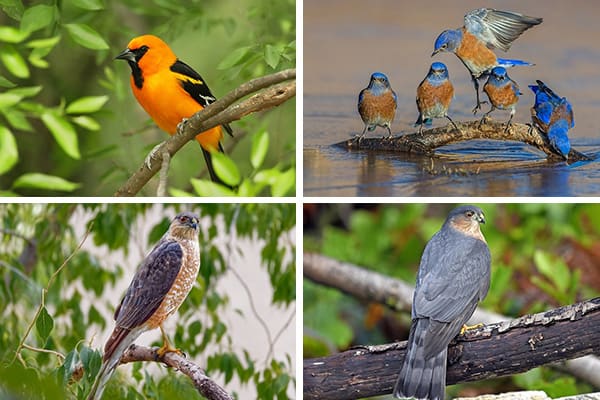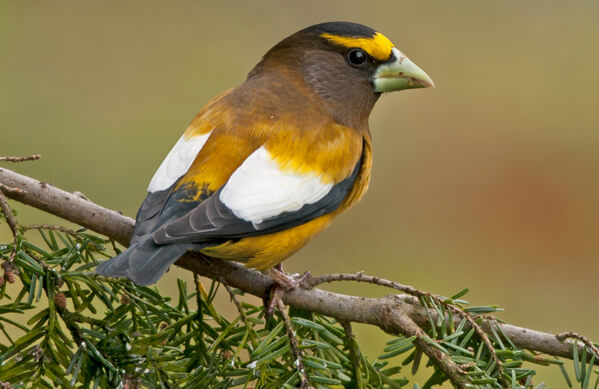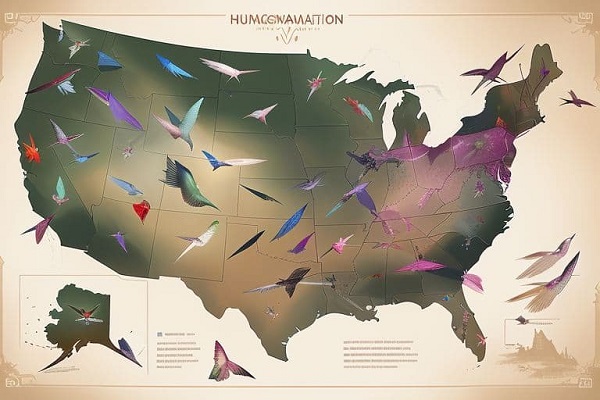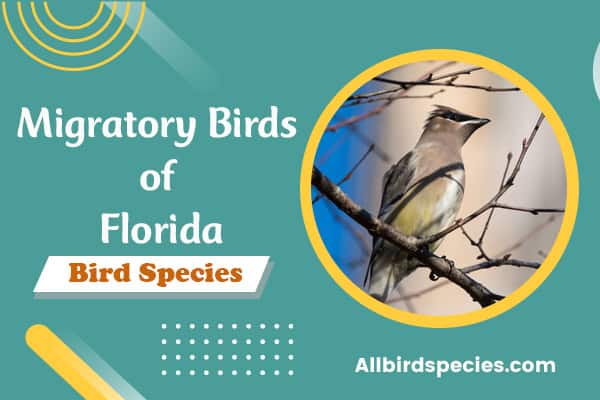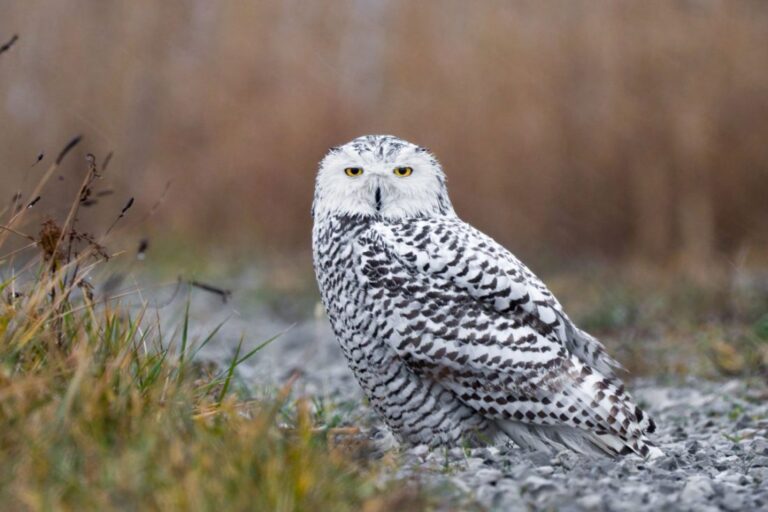11 Birds With Orange Chests of North America (With Pictures)
Curious about North American birds with orange chests? Prepare to be captivated as I introduce you to 19 fascinating species that showcase this striking feature. From the iconic Eastern Bluebird to the stunning Baltimore Oriole, these birds are sure to leave you in awe.
Have you ever wondered why some birds have such bold and eye-catching orange chests? What purpose does this vibrant color serve? Join me on a journey through the diverse avian landscape of North America as we uncover the mysteries behind this stunning characteristic.
Key Takeaways:
- Explore 19 bird species with orange chests found in North America
- Discover the reasons behind their vibrant plumage
- Learn about their habitats and distribution across the continent
- Uncover the unique behaviors and adaptations of these birds
- Appreciate the beauty and diversity of North American birdlife
Here we’ll explore 11 Different Types Of Birds With Orange Chests (Orange Breasted Birds)
1. Eastern Bluebird (Sialia sialis)
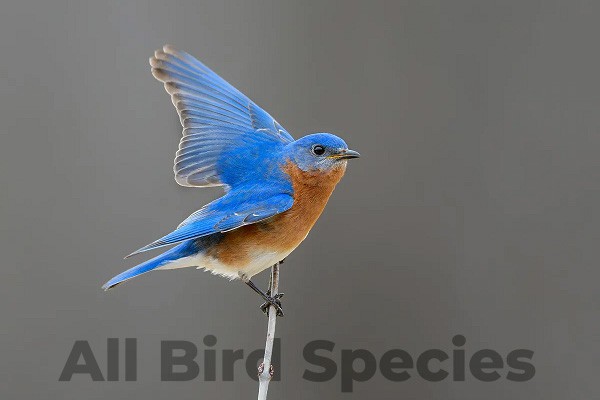
The Eastern Bluebird, scientifically known as Sialia sialis, is a small thrush species that showcases a captivating blend of blue and orange plumage. Among its striking features is the distinct orange chest, which sets it apart from other birds.
With its vibrant colors, the Eastern Bluebird is a visual treat for bird enthusiasts and casual observers alike. The combination of the bright blue wings and the contrasting orange chest creates a remarkable and eye-catching display.
This species is commonly found in open woodlands, meadows, and suburban areas throughout Eastern North America. The Eastern Bluebird’s preference for open areas and nesting in cavities makes it a delightful sight for birdwatchers.
The Eastern Bluebird’s distinct orange chest is highly recognizable and makes it a delightful sight to behold.
It should be noted that the Eastern Bluebird is an insectivore, feeding primarily on insects and small invertebrates. To support their populations, bird enthusiasts often provide nest boxes for these beautiful birds, as they offer safe and suitable nesting sites.
- The Eastern Bluebird belongs to the family Turdidae, which includes thrushes and robins.
- Males have deep blue plumage on their wings and back, while females exhibit a more muted blue-gray coloration.
- Their vibrant orange chests serve as an important visual signal, indicating their health and vitality during courtship and breeding seasons.
Conservation Status
The Eastern Blue birds with orange chests has shown encouraging population growth in recent years, largely thanks to conservation efforts focused on enhancing suitable nesting habitats and the widespread adoption of nest boxes. These initiatives have helped mitigate the challenges posed by habitat loss and competition with other cavity-nesting bird species.
By providing the Eastern Bluebird with nesting opportunities and preserving their natural habitats, we can contribute to the conservation of this beautiful and iconic species for generations to come.
Fun Fact
Did you know? The Eastern Bluebird was designated as the state bird of New York and Missouri, making it a symbol of pride and appreciation for its beauty and ecological importance.
2. Western Bluebird (Sialia mexicana)

The Western Bluebird, scientifically known as Sialia mexicana, is a captivating bird species found predominantly in western regions of North America. Similar to its eastern counterpart, this beautiful bird boasts an eye-catching display of vibrant colors, including a stunning orange chest that serves as a striking contrast against its blue wings.
With its distinct plumage and cheerful melodies, the Western Bluebird is a favorite among birdwatchers and nature enthusiasts. Its presence adds a touch of elegance to the picturesque landscapes it inhabits.
| Characteristics | Habitat | Range |
|---|---|---|
| Blue wings Vibrant orange chest Small size | Open woodlands Meadows Desert edges | Western United States Parts of Canada Mexico |
3. Black-headed Grosbeak (Pheucticus melanocephalus)

The Black-headed Grosbeak, scientifically known as Pheucticus melanocephalus, is a stunning songbird that can be found in various parts of North America. With its black head and fiery orange chest, this bird is a true spectacle to behold.
Not only does the Black-headed Grosbeak captivate with its vibrant plumage, but it also enchants with its melodious song. From its elevated perch, this bird fills the air with a mesmerizing melody that echoes through the surrounding trees.
The Black-headed Grosbeak is a medium-sized bird and belongs to the cardinal family. Along with its distinct coloration, it exhibits a thick, conical bill that is well-suited for cracking open seeds and foraging for insects. In addition, its wings are adorned with striking white patches that accentuate its appearance in flight.
During the breeding season, male Black-headed Grosbeaks use their vibrant plumage to attract potential mates. Their fiery orange chest is a symbol of strength and vitality, making them stand out among the foliage. Meanwhile, the females possess a more subdued plumage, blending in with their surroundings to protect their nests.
Interesting Facts about the Black-headed Grosbeak:
- The Black-headed Grosbeak is known for its long-distance migration, traveling all the way from Central America to its breeding grounds in North America.
- These birds prefer to nest in deciduous and mixed woodlands, where they can find ample food sources and suitable nesting sites.
- Black-headed Grosbeaks have a diverse diet, feeding on a variety of seeds, fruits, insects, and even spiders.
- Despite their striking orange chest, these birds are experts at blending in with their surroundings, making them somewhat elusive to spot.
With its striking appearance and enchanting song, the Black-headed Grosbeak is truly a remarkable species in the avian world. The contrast between its black head and fiery orange chest makes it a stand out among its feathered peers, captivating both bird enthusiasts and casual observers alike.
4. Cooper’s Hawk (Accipiter cooperii)

Cooper’s Hawk is a medium-sized bird of prey known for its prowess in hunting smaller birds. This magnificent avian species, scientifically known as Accipiter cooperii, showcases a stunning rust-colored chest that adds to its allure. The vibrant orange plumage serves a dual purpose – not only does it make this hawk visually striking, but it also provides effective camouflage while hunting its prey.
With its sharp talons and remarkable agility, the Cooper’s Hawk navigates through forests and urban areas, swooping down on unsuspecting birds. Its orange chest blends seamlessly with the trees and foliage, making it difficult for its prey to spot its approach. This adaptation allows the Cooper’s Hawk to surprise and capture its quarry with unmatched precision.
This bird of prey is found throughout North America, from Canada to Mexico, and is a common sight in both rural and suburban landscapes. Its hunting techniques and distinct orange chest make it a favorite subject among birdwatchers and wildlife enthusiasts alike.
“The Cooper’s Hawk’s ability to blend in with its surroundings through its rust-colored chest is truly fascinating. It’s a perfect example of nature’s ingenious adaptations.” – Birdwatching enthusiast
Cooper’s Hawks have a broad diet that primarily consists of birds, including pigeons, doves, and smaller songbirds. These skilled predators are known to chase their prey at high speeds, utilizing their sharp vision and maneuverability to their advantage.
Below is a table summarizing key details about the Cooper’s Hawk:
| Traits | Information |
|---|---|
| Scientific Name | Accipiter cooperii |
| Size | 16-20 inches (40-51 cm) |
| Wingspan | 31-37 inches (79-94 cm) |
| Habitat | Forests, woodlands, urban areas |
| Range | North America |
| Diet | Primarily birds |
5. Sharp-shinned Hawk (Accipiter striatus)

The Sharp-shinned Hawk, scientifically known as Accipiter striatus, is a powerful predator with a distinctive orange chest. Resembling the Cooper’s Hawk, these birds possess exceptional agility and can be found throughout North America.
With a sleek build and sharp talons, the Sharp-shinned Hawk is perfectly adapted for hunting smaller birds in dense vegetation. Its plumage showcases a beautiful mix of dark and light coloration, accentuated by the striking orange chest.
These birds with orange chests are renowned for their swift flight and precision in capturing prey mid-air. They rely on their quick reflexes and stealthy approach to surprise unsuspecting targets. Due to their exceptional hunting skills, the Sharp-shinned Hawk plays a vital role in regulating populations of small birds and maintaining ecological balance.
Here are some interesting facts about the Sharp-shinned Hawk:
- The Sharp-shinned Hawk belongs to the family Accipitridae, which includes various bird of prey species.
- They have a wingspan of approximately 24-27 inches (61-69 cm) and weigh around 4-7 ounces (113-198 grams).
- These hawks are skilled fliers, known for their rapid, acrobatic maneuvers during flight.
- Their diet primarily consists of small birds, such as sparrows, finches, and jays.
- During the breeding season, they construct nests using twigs and branches high up in trees, ensuring a secure environment for their young.
6. Allen’s Hummingbird (Selasphorus sasin)
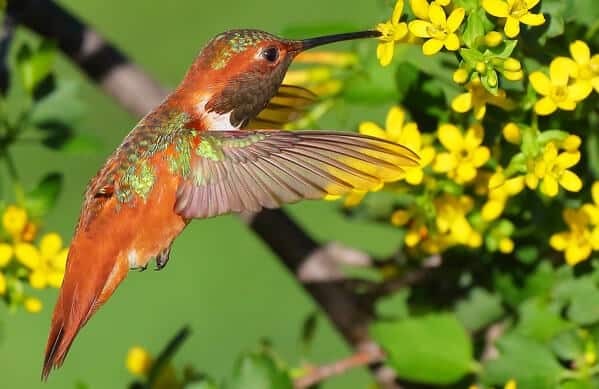
I’m excited to introduce you to Allen’s Hummingbird, a small and vibrant bird that is sure to captivate your attention. Known for its stunning orange throat and chest, this species, scientifically known as Selasphorus sasin, is primarily found in the western United States.
What sets Allen’s Hummingbird apart from other hummingbird species is its incredible agility. With its rapid wingbeats and precise flight maneuvers, it’s a true marvel to witness in action.
Whether it’s darting from flower to flower in search of nectar or engaging in aerial displays to attract a mate, Allen’s Hummingbird’s vibrant plumage and graceful movements make it a favorite among bird enthusiasts.
Characteristics of Allen’s Hummingbird:
- Distinctive orange throat and chest
- Small size, measuring around 3.5 inches in length
- Rapid wingbeats, averaging 53 beats per second
- Feeds primarily on nectar from flowers, supplemented with small insects and spiders
- Builds small cup-shaped nests using plant fibers and spiderwebs
“Observing Allen’s Hummingbird in flight is like witnessing a living jewel. Its vibrant colors and acrobatic maneuvers never fail to leave me in awe.”
Whether you’re a seasoned birdwatcher or simply appreciate the beauty of nature, encountering Allen’s Hummingbird is an experience that will undoubtedly leave a lasting impression.
| Species | Scientific Name | Location |
|---|---|---|
| Allen’s Hummingbird | Selasphorus sasin | Western United States |
7. Rufous Hummingbird (Selasphorus rufus)
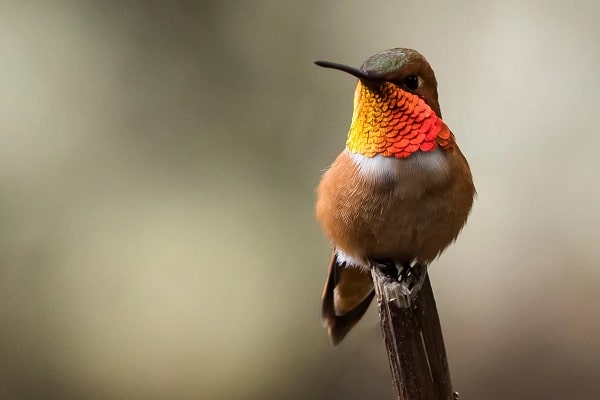
The Rufous Hummingbird, scientifically known as Selasphorus rufus, is a captivating species with its vibrant orange-red chest. These tiny birds embark on remarkable migratory journeys, covering vast distances across various parts of North America.
With their dazzling plumage and incredible agility, Rufous Hummingbirds are a favorite among birdwatchers and nature enthusiasts. They are known for their swift and precise flight, hovering in mid-air as they feed on nectar from brightly colored flowers.
During the breeding season, male Rufous Hummingbirds engage in impressive aerial displays to attract females. These displays involve intricate flight patterns and high-speed dives, showcasing their remarkable agility and vibrant colors.
These tiny birds with orange chests can be found in a wide range of habitats, including mountain forests, coastal areas, and even suburban gardens. They are often spotted during the spring and summer months when they migrate from their wintering grounds in Mexico and Central America.
These remarkable birds play an important role in pollination, as they transfer pollen from one flower to another while feeding on nectar. They are also known to defend their territories fiercely, engaging in aggressive encounters with other hummingbirds.
If you’re fortunate enough to spot a Rufous Hummingbird, make sure to observe their breathtaking beauty and delicate nature. These tiny avian gems are a true testament to the wonders of North American birdlife.
8. Red Knot (Calidris canutus)

The Red Knot is a fascinating medium-sized shorebird that can be found along the coasts of North America. These birds With orange chests and long, straight bill, the Red Knot stands out among other shorebird species. It is known for its impressive migratory patterns, traveling vast distances during its annual migration.
The Red Knot’s orange chest is a striking feature that adds to its allure. This vibrant coloring is especially prominent during the breeding season, when the birds display their most brilliant plumage. It serves as a visual attraction, making them even more captivating to birdwatchers and nature enthusiasts.
One of the remarkable aspects of the Red Knot is its ability to undertake long and arduous journeys. These birds travel thousands of miles each year, migrating from their breeding grounds in the Arctic to their wintering grounds along the coasts of North America. They rely on a network of critical stopover sites to rest and refuel, making their migratory journey a truly remarkable feat.
Conservationists and scientists closely monitor the Red Knot population, as it faces numerous threats to its survival. The degradation of coastal habitats and climate change pose significant challenges to the Red Knot’s feeding and breeding grounds. Efforts are underway to protect and restore these vital habitats to ensure the long-term survival of this remarkable species.
Next time you find yourself near the coast of North America, keep an eye out for the Red Knot. Its stunning orange chest and its incredible migratory journey make it a species worth admiring and protecting.
| Common Name | Scientific Name | Habitat | Migration |
|---|---|---|---|
| Red Knot | Calidris canutus | Coastal areas | Long-distance migrant |
9. Red-breasted Nuthatch (Sitta canadensis)

The Red-breasted Nuthatch is a small songbird with a reddish-orange chest. These energetic birds are often found in coniferous forests and can be recognized by their unique calls.
10. Altamira Oriole (Icterus gularis)
The Altamira Oriole is a stunning bird species with a bright orange chest and black wings. Known scientifically as Icterus gularis, this beautiful bird is mainly found in the southern regions of the United States and Mexico. With its vibrant plumage and melodious song, the Altamira Oriole can captivate birdwatchers and nature enthusiasts alike.
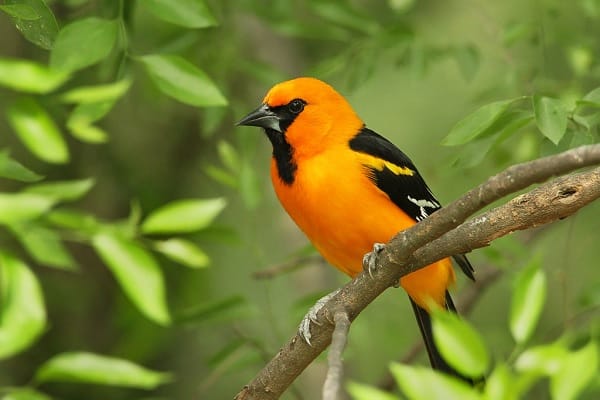
Physical Characteristics
The Altamira Oriole is a medium-sized bird, measuring approximately 23 centimeters in length. It has a distinctive coloration, featuring a vibrant orange chest that contrasts with its black wings. The male and female Altamira Orioles have a similar appearance, making it challenging to distinguish between the sexes based on plumage alone. However, the male often has a slightly larger bill compared to the female.
Habitat and Distribution
The Altamira Oriole birds with orange chests is primarily found in dense, semi-open habitats such as riparian woodlands, thorn forests, and mangroves. It prefers areas with an abundance of large trees for nesting and foraging. This species is endemic to southern Texas in the United States and extends southward into eastern Mexico.
Behavior and Diet
Altamira Orioles are known for their acrobatic displays and agile movements among tree branches. They have a varied diet that includes nectar, fruits, insects, and spiders. The Orioles often forage by gleaning insects from foliage or hanging upside down to reach nectar from flowers.
Conservation Status
The Altamira Oriole is currently classified as a species of least concern by the International Union for Conservation of Nature (IUCN). However, habitat loss and degradation due to deforestation and urbanization pose significant threats to their populations. Conservation efforts focused on preserving their preferred habitats and raising awareness about their importance are crucial for the long-term survival of this beautiful bird.
| Altamira Oriole | Icterus gularis |
|---|---|
| Size | Approximately 23 centimeters in length |
| Plumage | Bright orange chest and black wings |
| Habitat | Dense, semi-open habitats such as riparian woodlands, thorn forests, and mangroves |
| Distribution | Southern regions of the United States and Mexico |
| Diet | Nectar, fruits, insects, and spiders |
| Conservation Status | Species of least concern |
11. Baltimore Oriole (Icterus galbula)
The Baltimore Oriole, scientifically known as Icterus galbula, is one of the most iconic birds with orange chests found in North America. Its vibrant chest and striking black and orange plumage make it a favorite among birdwatchers and nature enthusiasts alike. These beautiful birds are commonly spotted in the eastern and central parts of the United States, particularly during the spring and summer months when they migrate from their tropical wintering grounds.
The Baltimore Oriole is known for its distinct song, which fills the air with a delightful melody. These birds are highly skilled nest builders and construct intricate hanging nests made of plant fibers, hair, and other materials. The female Baltimore Oriole is responsible for building the nest, while the male defends their territory and forages for food.
During the breeding season, the Baltimore Oriole feeds mainly on insects, spiders, nectar, and fruits. It uses its specialized beak to probe flowers for nectar and extract insects from the foliage. In the winter, these birds switch to a diet primarily composed of fruits, including oranges and berries.

